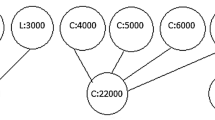Abstract
This paper examines thesystem of Qualified Majority Voting, usedby the Council of the European Union, fromthe perspective of enlargement of theUnion. It uses an approach based on powerindices due to Penrose (1946), Banzhaf (1965) and Coleman(1971) to make two analyses: (1) the question ofthe voting power of member countries fromthe point of view of fairness, and (2) thequestion of how the threshold number ofvotes required for QMV should bedetermined. It studies two scenarios forchange from 2005 onwards envisaged by theNice Treaty: (1) no enlargement, the EUcomprising 15 member countries, and (2)full enlargement to 27 members by theaccession of all the present twelvecandidates. The proposal is made that fairweights be determined algorithmically as atechnical or routine matter as themembership changes. The analysis of how thethreshold affects power shows thetrade-offs that countries face betweentheir blocking power and the power of theCouncil to act. The main findings are: (1)that the weights laid down in the NiceTreaty are close to being fair, the onlysignificant discrepancies being theunder-representation of Germany andRomania, and the over-representation ofSpain and Poland; (2) the thresholdrequired for a decision is set too high forthe Council to be an effective decisionmaking body.
Similar content being viewed by others
References
Baldwin, R.E., Berglof, E., Giavazzi, F. and Widgren, M. (2001). Nice try: Should the Treaty of Nice be ratified? Monitoring European Integration 11. London: Centre for Economic Policy Research.
Banzhaf, J.F (1965). Weighted voting doesn't work: A mathematical analysis. Rutgers Law Review 19: 317-343.
Coleman, J.S. (1971). Control of collectivities and the power of a collectivity to act. In B. Lieberman (Ed.), Social choice, 277-287. New York: Gordon and Breach.
Dubey, P. and Shapley, L.S. (1979). The mathematical properties of the Banzhaf index. Mathematics of Operations Research 4: 99-131.
EU (2001). Treaty of Nice amending the Treaty of the European Union, the treaties establishing the European Communities and certain related acts. EU Document CONFER 4820/00 28 February.
Felsenthal, D.S. and Machover, M. (1998). The measurement of voting power: Theory and practice, problems and paradoxes. Cheltenham: Edward Elgar.
Felsenthal, D.S. and Machover, M. (2000). Enlargement of the EU and weighted voting in its Council of Ministers. London: London School of Economics and Political Science, Centre for Philosophy of Natural and Social Science, VPP 01/00, http://www.lse.ac.uk/votingpower.
Felsenthal, D.S. and Machover, M. (2001a). Myths and meanings of voting power: Comments on a symposium. Journal of Theoretical Politics 13: 81-97.
Felsenthal, D.S. and Machover, M. (2001b). The Treaty of Nice and qualified majority voting. Social Choice and Welfare 19: 465-483.
Garrett, G. and Tsebelis, G. (1996). An institutional critique of intergovernmentalism. International Organization 50: 269-299.
Garrett, G. and Tsebelis, G. (1999). Why resist the temptation of power indices in the EU and More reasons to resist the temptation of power indices in the EU. Journal of Theoretical Politics 11: 291-308 and 331-388.
Hosli, M. (1993). The admission of the European Free Trade Association States to the European Community: Effects on voting power in the European Community Council of Ministers. International Organization 47: 629-643.
Hosli, M. (1995). The balance between small and large: Effects of a double-majority system on voting power in the European Union. International Studies Quarterly 39: 351-370.
Hosli, M. (1996). Coalitions and power: Effects of qualified majority voting in the Council of the European Union. Journal of Common Market Studies 34: 255-273.
Hosli, M. (1998). An institution's capacity to act: What are the effects of majority voting in the Council of the EU and the European Parliament?. Current European Issues; Maastricht, European Institute of Public Administration.
Lane, J.-E., and Berg, S. (1999). Relevance of voting power. Journal of Theoretical Politics 11: 309-319.
Laruelle, A. and Widgren, M. (1998). Is the allocation of voting power among EU states fair?. Public Choice 94: 317-339.
Leech, D. (2000). Voting power and the governance of the International Monetary Fund. CSGR Working Paper No. 68/01, Centre for the study of Globalisation and Regionalisation, University of Warwick, December 2000; forthcoming in Annals of Operations Research, special issue on Game Practice.
Leech, D. (2001a). ipexact: A computer program for computing measures of power in a weighted voting body. Department of Economics, University of Warwick.
Leech, D. (2001b). ipnice: A computer program for the analysis of qualified majority voting power under the Treaty of Nice. Department of Economics, University of Warwick.
Leech, D. (2001c). Computing power indices for large weighted voting games. Warwick Economic Research Papers, Number 579 (revised January 2001).
Leech, D. (2002). An empirical comparison of the performance of classical power indices. Political Studies 50: 1-22.
Nurmi, H. (1982). The problem of the right distribution of voting power. In M.J. Holler (Ed.), Power, voting and voting power. Würzburg, Physica.
Nurmi, H. and Meskanen, T. (1999). A priori power measures and the institutions of the European Union. European Journal of Political Research 35: 161-179.
Penrose, L.S. (1946). The elementary statistics of majority voting. Journal of the Royal Statistical Society 109: 53-57.
Shapley, L. S. and Shubik, M. (1954). A method for evaluating the distribution of power in a committee system. American Political Science Review 48: 787-792.
Sutter, M. (2000). Fair allocation and re-weighting of votes and voting power in the EU before and after the next enlargement. Journal of Theoretical Politics 12: 433-449.
Widgren, M. (1994). Voting power in the EU and the consequences of two different enlargements. European Economic Review 38: 1153-1170.
Author information
Authors and Affiliations
Rights and permissions
About this article
Cite this article
Leech, D. Designing the Voting System for the Council of the European Union. Public Choice 113, 437–464 (2002). https://doi.org/10.1023/A:1020877015060
Issue Date:
DOI: https://doi.org/10.1023/A:1020877015060




